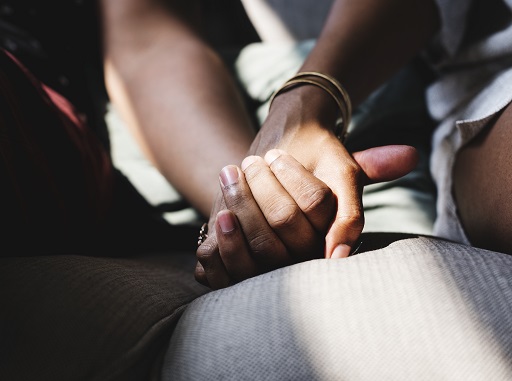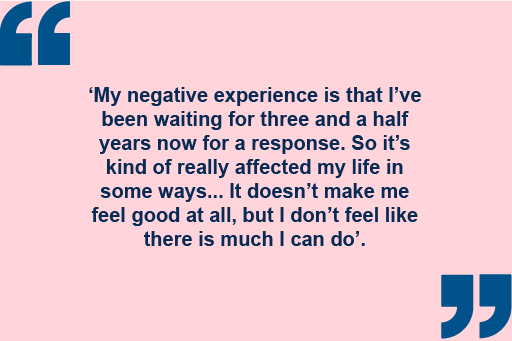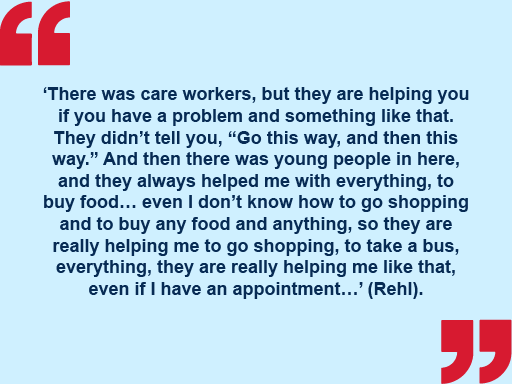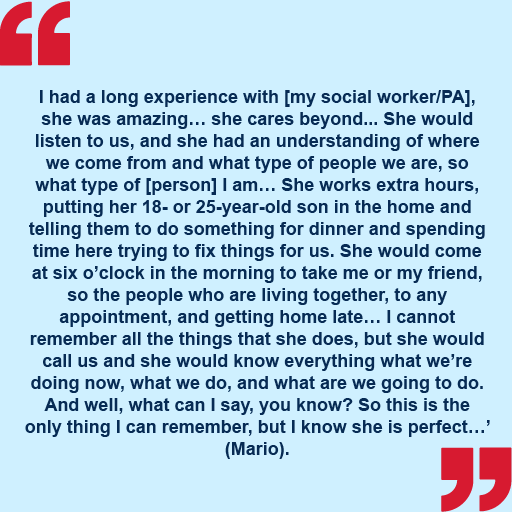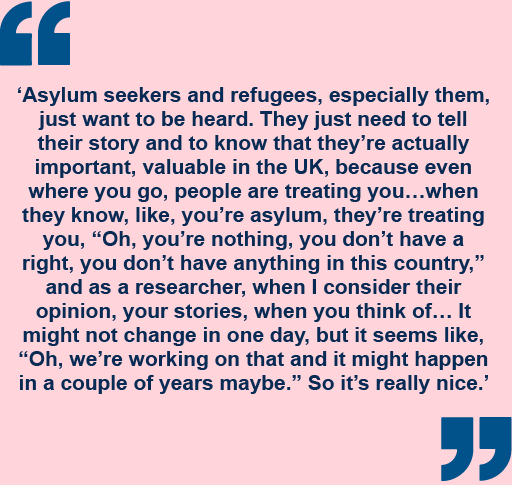Use 'Print preview' to check the number of pages and printer settings.
Print functionality varies between browsers.
Printable page generated Saturday, 22 November 2025, 12:23 PM
5: UASC’s perspectives on care
5: UASC’s perspectives on care
In this section, you are going to focus on the perspectives of the young people who took part in the Children Caring on the Move (CCoM) project. We know from the research that the events that prompt young people’s migration to a new country are often traumatic and destabilise their sense of self. As they move through their migratory journey and continue to claim asylum, they each experience a ‘trail of events’ that transform their world, shake their identities and in the case of the study by Chase (2013), ‘set them on trajectories over which they had no control’ (pp. 862). However, the CCoM study had a specific focus, which was to explore their thoughts, feelings and perceptions of ‘care’. One way in which the team of young researchers (who were unaccompanied migrants themselves) and the research team undertook this exploration of care was through the collaborative development of a short digital film. The film is called ‘Stories too big for a case file’ and showcases the testimonies unaccompanied young people shared with us as they navigate the complex immigration-welfare system in the UK.
First, we explain how the film was created. Then, we have broken the film down into three parts and will ask you to listen to each part, and reflect on the content. If you have been experiencing some extremely challenging situations as part of your social care work with UASC, hearing their perspectives might evoke some strong emotions. As you listen to each part, attempt to put yourself in their shoes and think about how their views might be similar or different from your own. Where are the departures and why do you think there are differences?
5.1: Making the film
The process of making the film started with young researchers and University researchers meeting online (due to the Covid-19 pandemic) to reflect on the stories they were hearing during the interviews with other young unaccompanied people. The research team discussed the main themes that were taking centre stage in these stories, and they felt they wanted to share these with a wider audience such as professionals, academics and other unaccompanied young people in the UK. We have made a decision to present these stories through a film, because it fits with our participatory approach of doing co-collaborative research with the young people and because we hoped that through this medium, the stories will reach more young people and communities.
Following these discussions, the University-based researchers searched for quotes in the interview transcripts that were illustrating the themes. These quotes were then re-voiced by members of the team, mainly the young researchers, and images and videos of places the young people have referred to during their interviews were taken, as well as images reflecting the stories they have shared with them.
Further reading
For more information about the process of making the film:
 Activity 5.1: Seeing ‘Me’
Activity 5.1: Seeing ‘Me’
Part 2
After listening to these young people’s descriptions of their identity and how the challenges of being as UASC impacts their sense of self:
- What practices do you engage in to support young people through difficult processes?
- In your experience, have there been any particular activities that have worked well when supporting young people?
During the first part of the film, you were invited to link these stories to the notion of self and identity. How we see ourselves and the changes in our identity are often influenced by our social context. Let’s take ‘waiting’ for their asylum application’s outcome as an example. Research suggests that it is a central feature of the experience of the unaccompanied young people which place them in limbo, characterised by insecurity and anxiety (Chase, 2013). As Ardian told us:
The first segment of the film talks about the ways the hostile immigration environment and complex immigration processes subjects unaccompanied young people to a climate of suspicion and exclusion (Crafter et al., 2021; Rosen et al., 2021). We know from our own research with professionals and social care practitioners that they are very aware of these difficulties but that their different roles and responsibilities can leave them with very limited room to manoeuvre in terms of their support for young people (Crafter et al., 2021).
 Pause for reflection: Care versus process
Pause for reflection: Care versus process
Drawing on your own social care practices, what are your thoughts about how ‘care’ can be sustained in a system focused on time, processes and procedures? What kind of ‘caring’ practices do you engage in to help with this uncertainty?
Make some notes in the box below.
Let us turn now to the next segment of film which focuses more on care practices and caring relationships.
5.2: Young people’s care practices and caring relationships
The Children Caring on the Move research suggested that ‘care’ means lots of different things to different unaccompanied young people. Young people talked to us about their relationships with other young people, and how they care for each other (see also Section 3.2). Sometimes, young people take a ‘family-like’ role, and other times they become mentors/advisors to other young people. Clearly, there are also important relationships with social care professionals and other key adults. Let’s watch the second segment of film.
 Activity 5.2: Seeing ‘You’
Activity 5.2: Seeing ‘You’
In the second half of the film, the young people talk about the variety of relationships they have with other young people and adults. After watching the second part of the video, draw a mind map on a piece of paper, depicting the relationships with significant others these young people talk about and reflect on the following:
- What made them important?
- What do you think young people value as caring in these relationships?
Transcript
Discussion
You may have noted that the clip can be split into three broad areas:
- Disruption to relationships.
- Developing care relationships with other young people.
- Developing relationships with adults.
It is clear from this clip that establishing relationships with other young people is an incredibly important part of their experience. However, a disruption to the continuity of these relationships can have a negative impact.
You may have got a sense of how significant their care relationship with other young people can be. For example, one young person felt very alone when they arrived in the UK, but in establishing relationships realised there was a lot of potential in the development of a new self in a new context – being someone new and ‘doing more’ with the support of other young people.
Not surprisingly, adult relationships, when positive, were extremely impactful. Hopefully, you noted that a positive adult relationship was framed in terms of kindness or being ‘lovely’ and being present or helpful – someone who ‘checks-in’ and are part of the key processes such as Home Office interviews. Someone to turn to, to manage challenging situations. Arguably, these are small but important acts of care.
But, when relationships were negative, you may have noted a link with racist attitudes and, in difficult relationships, nowhere to turn. The young people also recognised that social workers were overburdened with cases, making care challenging.
As mentioned earlier, a key focus on the CCoM project was to explore the experiences of young people’s care of each other. Building trust and relying on other young people for care was one example mentioned by one of our interviewees. Rehl describes how the young people in their shared house engage in a range of small acts of care:
If we reflect on the phases and moral elements of care that you explored in Section 2.1, these small acts of support come under the phase of ‘caregiving’ and ‘competence’. The young people in Rehl’s house were able to share their own learned competences and, in turn, were providing everyday forms of care.
Whilst we tend to hear, or focus on, the most negative stories about the relationships between young people and the adults in social care situations, some of the young people in our study did mention the acts of care that they valued from adults. Mario discusses this in this next quote:
As we know from Section 3.2, going above and beyond like the social worker in this quote can be emotionally draining and demanding.
 Pause for reflection: reflection on multiple stories
Pause for reflection: reflection on multiple stories
As you reflect on these discussions, what care practices do you engage in? What are the limitations or boundaries that you set and why? Have these stories affected the way you see and work with UASC?
Make some notes in the box below.
5.3: What would young people change?
In the final segment of the film, the young people speak of the ways they are trying to change the system, or the changes they want to see. As already mentioned in Section 1.2, CCoM was a participatory study and, as such, producing knowledge that was change-oriented was at the core of our collaborative practices. Being provided with an opportunity to talk about was highly valued by the young people in our study.
 Activity 5.3: Dreaming of change
Activity 5.3: Dreaming of change
Part 1
As before, listen to the young people talking about their desire for change. Think about the following questions and make notes:
- If you could change three things in the system for young people, what would these be?
- What kind of changes in the system could you make to support the professional-young person relationship?
Transcript
Part 2
After listening to these young people’s needs and desires for change, imagine and briefly describe a future session with a young person.
- What would you keep doing?
- What would you consider changing?
We will leave you with this final quote from one of our Young Researchers:
5.4: Section summary
In this section, we have listened to the narratives of young people through the medium of a digital film. The film raised a number of important themes, many of which you will be familiar with as a social care practitioner. Perhaps some key reflections to take away are around what the film tells us about how young people’s sense of self is tightly linked to the rhythms of their asylum claim. The study participants talked about their relationships with other young people and adults, and the significant impact it has on them when these relationships are disrupted. Of course, the final section of the film focused on change.
In the next section, you are going to complete your course by reflecting on all you have learnt.
Now, continue to 6: Supporting the care of UASC and their care of each other.
